The Australian island that feels like another country
21 March 2023
This far-flung, sparsely populated rock was born of isolation and rebellion and has a character unlike anywhere else.
By CAROLYN BEASLEY
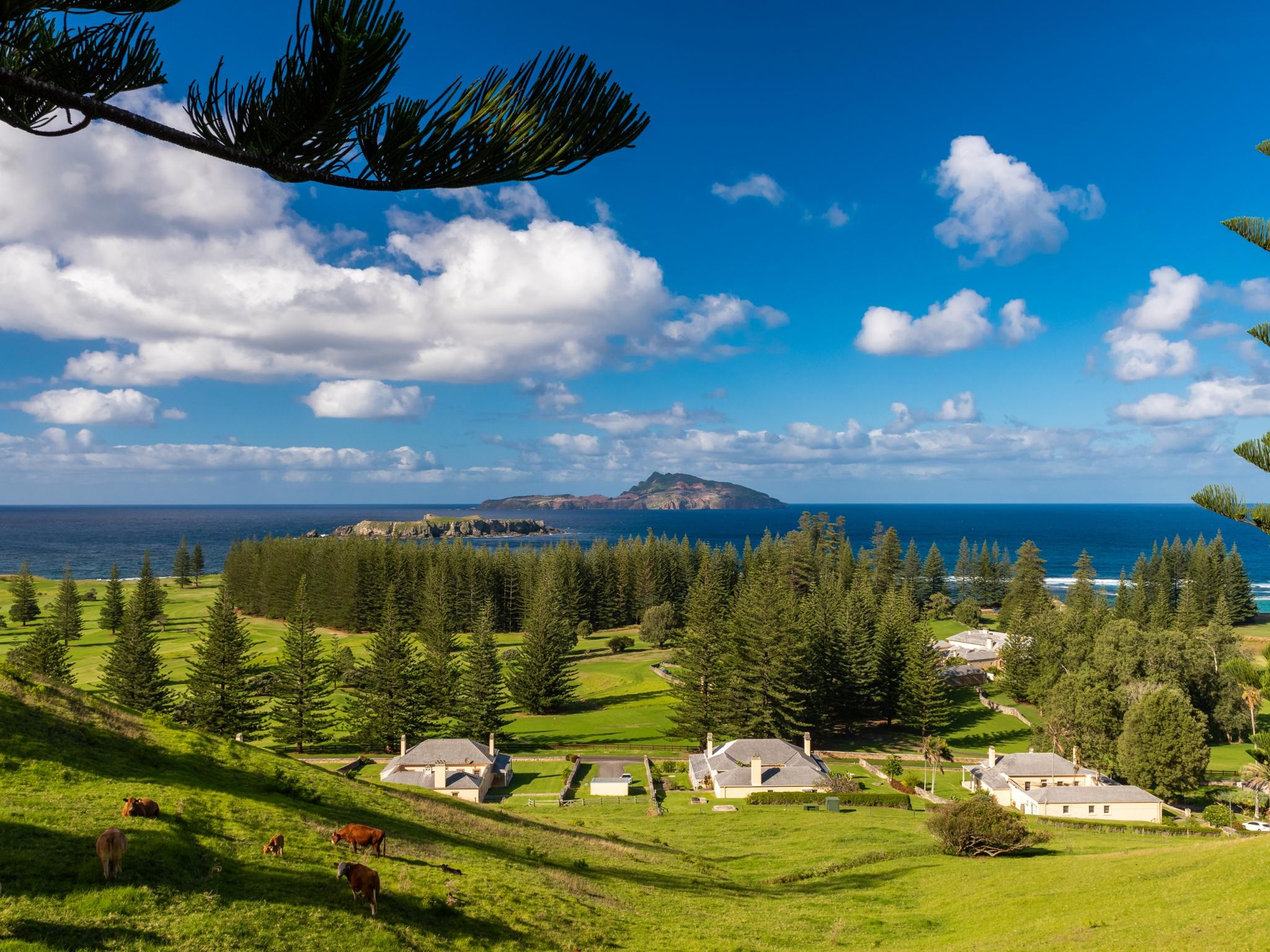
From TravelMarch 18, 20237 MINUTE READ50
We know who’s a tourist at the supermarket,” says Hayley Smith. “They’re the ones locking their cars. Me, I just leave mine running.” Smith is my bus driver for an orientation tour of Norfolk Island, included with a stay at many of the destination’s accommodation options.
The relaxed attitude to security is just one of the quirks of life on this far-flung rock, about 1600km northeast of Sydney, but my first encounter with Norfolk’s uniqueness occurs in Brisbane, when my flight from the state capital departs from the international terminal, and I have to show my passport for a domestic flight. Technically, the 34sq km island is an external territory of Australia, and since 2016 its residents pay Australian tax. While many on the island are pleased to receive entitlements such as Medicare, most don’t feel “Australian”.
I can see their point; there are more differences here than you might expect. Born of an unusual combination of historical circumstances, the culture is distinctive. To better understand its three main layers of history, I visit the ruins and museums at the UNESCO World Heritage-listed settlement of Kingston.
READ NEXT
WORLDPutin’s envy for Xi’s great leap forwardWILL GLASGOW
Between 1150AD and 1450AD, the island was inhabited by Polynesians. For decades, archaeologists thought they only frequented the coast, but artefacts found last year near the island’s highest point indicate their habitation was widespread.
The island was claimed for the British in 1774 by James Cook, who thought the towering Norfolk Pines would make excellent ship masts (they didn’t). A British colony was established just six weeks after the First Fleet arrived in Port Jackson in 1788. But the challenges were insurmountable, and the settlement was abandoned by 1814, then revived as a brutal convict station from 1825 to 1855.
The third wave of settlers hailed from Pitcairn Island, descendants of the mutineers who commandeered William Bligh’s HMS Bounty in 1789, and their Tahitian wives. Officially British subjects, they had exhausted Pitcairn’s resources, and in 1856 Queen Victoria gave them Norfolk Island, some 6000km away. Today, eight and nine generations later, one third of islanders, of whom there are fewer than 2000, trace their heritage to the rebels.
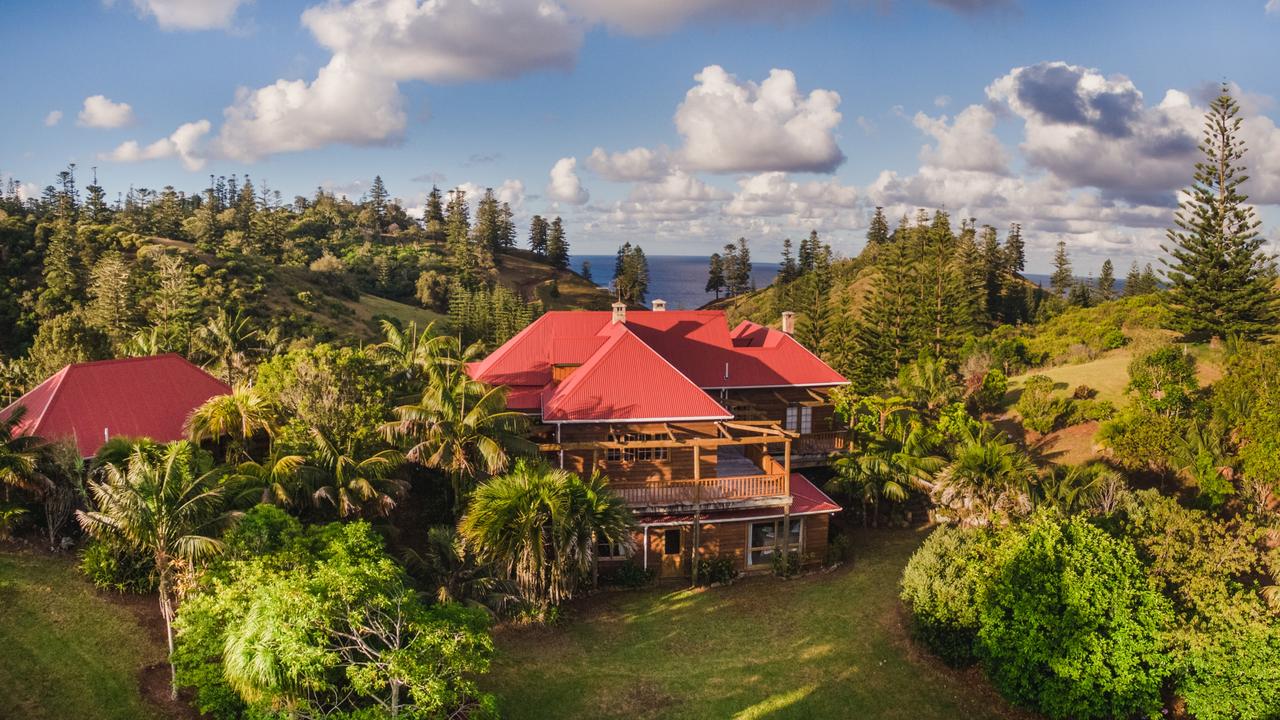
One such descendant is the owner of Tintoela Homestead, where I’m staying. Hunky Evans constructed this elegant, six-bedroom house from Norfolk Pine and with wife Laurie raised five children here. Out the back, lush fruit trees give way to a gurgling creek. Chickens roam free, scratching through the fallen flowers of the huge Norfolk Island hibiscus. French doors at the front lead to a timber veranda, where two plantation chairs invite contemplation of the view. A grassy valley slices through two hills, and terminates where the creek tumbles into the ocean at Cascades Bay.
I’m walking to this basin when a tiny Daihatsu ute containing an older couple and their dog bumps towards me. The couple waves and I gesture back, slightly confused. But I soon realise everybody here waves; it’s their default friendly disposition. There are many other differences, too.
Tania Anderson of Norfolk Island Tourism greets me with “Watawieh”. She explains locals speak a language called N’folk, which is a blend of old naval English from the mutineers and the Tahitian language of their maternal ancestors.
“Growing up here, it was only the people who had been born on the island who spoke N’folk,” Anderson says. “But all that’s changed now. It’s even being taught in the school.”
For another interesting snippet of Norfolk life, Anderson suggests I check out the unloading of the supply ship. At the jetty, it’s apparent a treacherous reef prevents the vessel from docking, so it moors in deep water. Its crane lifts and suspends a swaying load, lowering it on to a barge, which lurches to the jetty, where it’s finally hoisted on to dry land.
For locals, the ship’s arrival is always welcome. “There’s no Bunnings just down the road here,” Anderson says with a laugh. When she orders online goods, she likes to include a treat, perhaps a favourite chocolate. When the delivery arrives at least three months later, she’s always surprised to find her little indulgence among the essentials.
Leaving the jetty, I drive the delightful backroads. Frequently I’m forced to stop and wait for cows who defiantly block the road, languidly chewing the cud. Every islander has the right to register 10 head for grazing along roadsides, so even non-farmers can raise cattle.
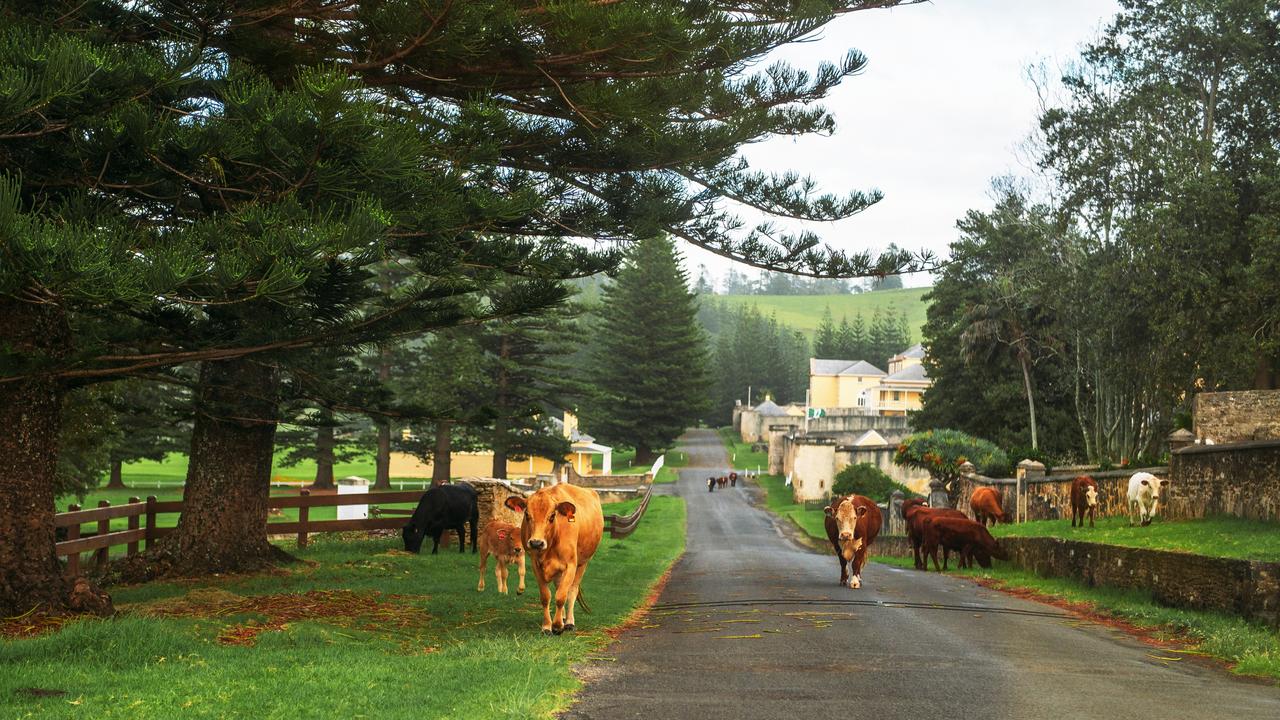
At the national parks office, I meet manager Nigel Greenup, who moved here from Queensland five years ago and loves the laid-back vibe, community spirit and the freedom enjoyed by local children. “It reminds me of the mainland back in the ’70s,” he says.
Norfolk has 52 species of bird, including the green parrot, which was previously one of the world’s rarest. To my amazement, Greenup steers me outside and points to the once elusive creatures, chattering in the adjacent tree. “We were down to less than 20 some years ago,” Greenup says. “They’re probably up around three or four hundred now.”
That recovery has been facilitated by controlling rats and the introduced crimson rosella, which competes for nesting spaces.
Norfolk Island National Park was established in 1986, but for locals, this stretch of bush had existing cultural value. “We allow for cultural collection of materials from the national park, like the Norfolk Island palm, which is used in weaving and making hats,” Greenup says. The non-native cherry guava is also retained in some areas so locals can make traditional cherry guava jelly. Dogs on leads are allowed and, in parts, so are horses.
“Those areas were traditionally used for horse riding, for getting back and forth between one part of the island and the other,” Greenup says. “We’re really conscious of that Norfolk Islander ownership and stewardship of the island and of the national park.”
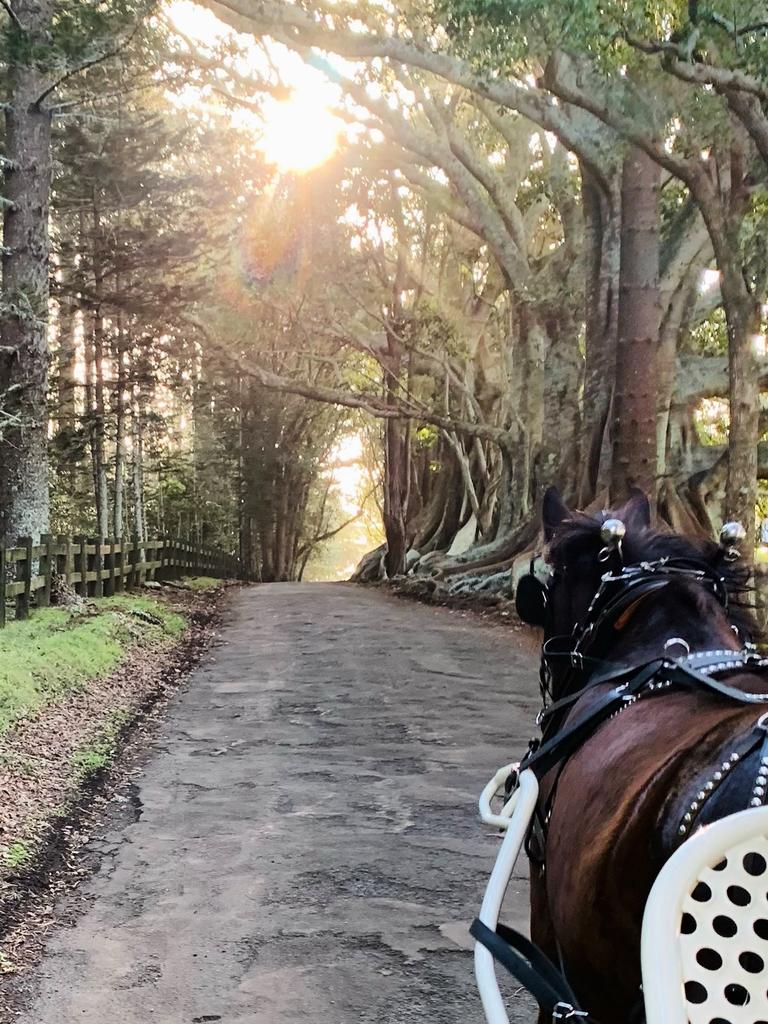
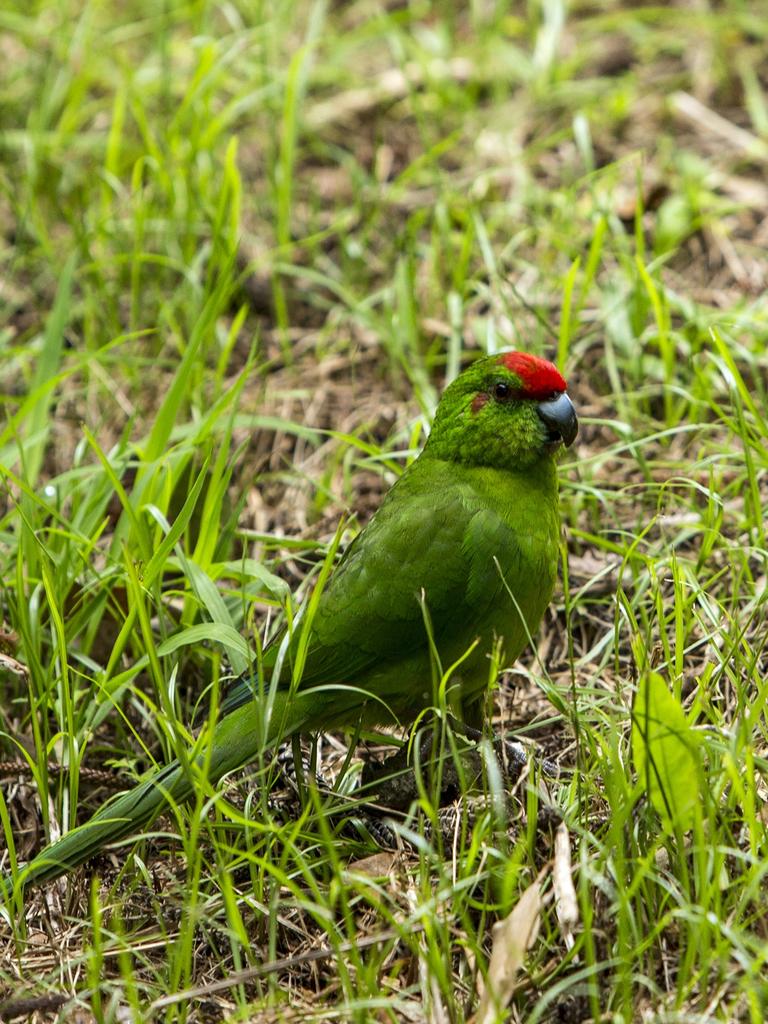
I hike through rainforest, under towering pines and along cliffs. On rocky outcrops below, nesting sooty terns occupy all available real estate. Who can blame them? The alternative nearest landfall is New Caledonia, almost 800km away. I also spot red-tailed tropic birds, a waddling masked booby, and white terns feeding fluffy chicks.
The rich soil and seas feed the population too, and much of the best produce is used at the island’s excellent dining venues. The Homestead Restaurant nestles beside giant Moreton Bay figs, and the twisted buttress roots make for an enchanting entrance to the 1930s farmhouse. Overlooked by a mounted stag head, I try the roasted bone marrow with sea urchin butter, followed by the kingfish in Sicilian broth. Impressed, I continue sampling fish at other restaurants during my stay. At Hilli Restaurant and Cafe, I devour the pan-seared trumpeter, while at the Bounty Bar and Grill, the same fish is topped with juicy scallops.
At some restaurants, the wine list is almost a lucky dip, with grape varieties and prices listed, but not always the winery where it was made. It’s a reflection of the uncertainties of supply. Many residents minimise such issues by growing fruit and vegetables and selling the surplus. At the markets, I buy potatoes, young corn and sweet bananas from the back of a ute to take back to Tintoela. The roadside stalls are a joy too, with their miscellaneous fruit and honesty boxes.
The most old-school experience of all is the Tea Shire Drive horse-drawn carriage tour, owned by PJ Wilson. His shire horse, called Big Girl, maintains a slow clop through the pretty forest of the Hundred Acres Reserve, trumpeting a whinny as she passes her horsey friends. When we finish the 90-minute drive, Wilson’s wife Ashley appears with high-tea made with homegrown produce.
By the end of my stay, I’m getting the hang of Norfolk life. I’m waving at strangers, patiently waiting for bovines and opening conversations with “Watawieh!”
In the airport carpark before I fly out, there’s only one thing left to do. As instructed in my car-hire agreement, I walk away from the car, leaving the keys in the ignition.

More to the story
Norfolk Island was spared the full force of Cyclone Garbrielle when it passed by the island in early February. While it downed some trees and powerlines, and one of the two jetties took a beating, Norfolk Island Tourism’s Tania Anderson says life and business are back to normal.
In the know
Qantas operates direct flights to Norfolk Island from Brisbane and Sydney several times a week.
Tintoela Homestead is a five-minute drive from the airport and the main township of Burnt Pine. The self-contained six-bedroom property sleeps up to 12 guests (from $750 a night). It also has a two-bedroom and one-bedroom cottage with private access.
The 90-minute Tea Shire Drive tour costs $75 a person, including afternoon tea. The tour is closed until July.
Homestead Restaurant is open for dinner Thursday to Saturday from 6pm.
Hilli Restaurant and Cafe is open Friday to Tuesday for lunch and dinner, plus morning Devonshire teas.
Bounty Bar and Grill serves lunch Wednesday to Saturday and dinner Tuesday to Sunday.
Carolyn Beasley was a guest of Norfolk Island Tourism.